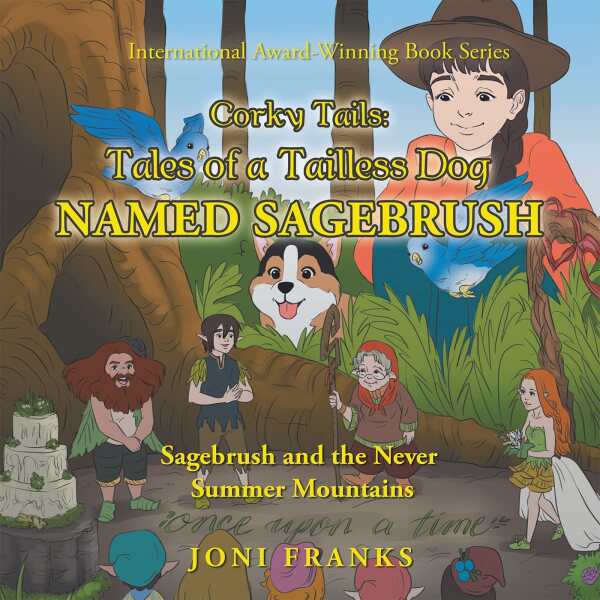Corky Tails: Tales of a Tailless Dog Named Sagebrush
Sagebrush and the Never Summer Mountains
In the picture book Sagebrush and the Never Summer Mountains, friends stand up to discrimination and ignorance while living in harmony with the natural world.
The latest installment in the Corky Tails series, Joni Franks’s adventuresome picture book Sagebrush and the Never Summer Mountains concerns environmental consciousness.
Clover Leaf is a Shun, a miniature woodland person living in the Never Summer Mountains, which are known for their extreme seasonal weather, including monsoons and blizzards. As he is gathering herbs to cure his mother’s blue flu, a hummingbird informs him and his friend Firefly of a landslide. It has blocked the river that is the Shuns’ main water source. Aghast, Clover Leaf and Firefly volunteer to assist Young Miss—a giant who owns the property where the Shuns live—in clearing the wreckage. With a talking dog, Sagebrush, to assist them, the group sets off to do their work. They encounter naysayers along the way.
Later on, Mr. Hunter Man and the Wooly Man—a bigfoot-like creature who lives in the forest—are introduced. Mr. Hunter Man is doubtful that a woman and small creatures like the Shuns can clear away the river blockage alone. In his exchange with Young Miss, he expresses humor at their struggle and his fear of the Wooly Man. Young Miss remains stalwart in her assertion that size, gender, and species do not matter, and that the Wooly Man means no harm, given his unnoticed presence in the forest. Her feminist and environmentalist message is an interesting development, though it leaves other characters, including Clover Leaf, Firefly, and Sagebrush, behind. The story works toward an abrupt ending in which the perils of the team’s adventure are over before they begin.
The prose is poetic, flowery, and rhythmic, particularly when it focuses on natural phenomena like the mountain storms. It also encompasses the homegrown foods and other substances that the Shuns use and create. The accompanying illustrations are detailed; characters are depicted with bright colors and expressions, and clean, rustic backgrounds emphasize the natural environment. However, the cleanliness and simplicity of the shading and strokes obscures the images’ movement, depth, and dimensionality, muddling sizes and scales. For example, the Shuns, Young Miss, Young Miss’s horse, and Sagebrush shift in their sizes against unstable foreground and background elements. Still, the charm of the Never Summer Mountains and its many inhabitants are conveyed in bright imagery and natural storytelling.
In the picture book Sagebrush and the Never Summer Mountains, friends stand up to discrimination and ignorance while living in harmony with the natural world.
Reviewed by
Aleena Ortiz
Disclosure: This article is not an endorsement, but a review. The publisher of this book provided free copies of the book and paid a small fee to have their book reviewed by a professional reviewer. Foreword Reviews and Clarion Reviews make no guarantee that the publisher will receive a positive review. Foreword Magazine, Inc. is disclosing this in accordance with the Federal Trade Commission’s 16 CFR, Part 255.

